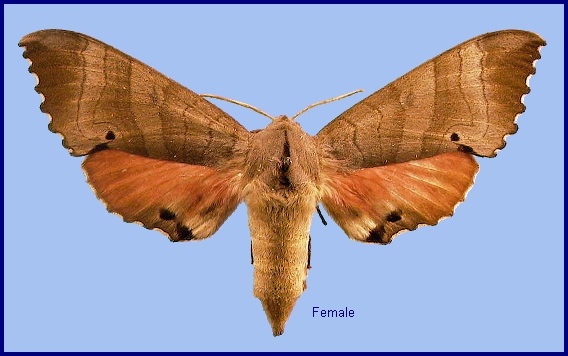
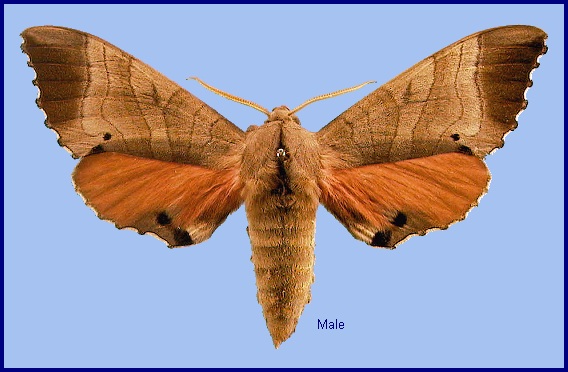
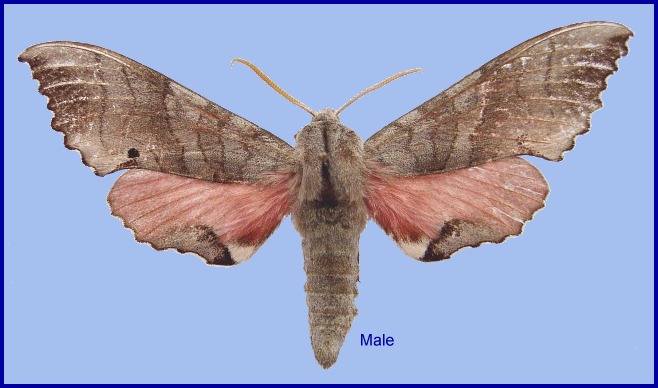
Smerinthus gaschkewitschii Bremer & Grey, 1853, In: Motschulsky (ed.), Etudes ent. 1: 62. Type locality: [China,] Pekin [Beijing].
Synonym. Marumba gashkevitshi Kuznetsova, 1906, Horae Societatis Entomologicae Rossicae 37: 293-346.
Synonym. Marumba gaschkewitschi [sic] discreta Derzhavets, 1977, Nasekomye Mongol. 5: 643. Type locality: Mongolia, Eastern Province, Bayandun.
Synonym. Marumba bremeri Eitschberger, 2012, Neue Entomologische Nachrichten 68: 46.
Synonym. Marumba gordeevorum Eitschberger & Saldaitis, 2012, Neue Entomologische Nachrichten 68: 46.
Synonym. Marumba greyi Eitschberger, 2012, Neue Entomologische Nachrichten 68: 47.
Note. Marumba gaschkewitschii is currently divided into four subspecies: Marumba gaschkewitschii gaschkewitschii, Marumba gaschkewitschii complacens (Walker), Marumba gaschkewitschii carstanjeni (Staudinger), and Marumba gaschkewitschii gressitti Clark. However, the boundaries between these are not clear-cut, particularly within China. Specimens matching two or more subspecies can be found in the same locality at the same time, for example, as was observed at Yangling (17.vii.1995) and 30km north of Huangling, Shaanxi (24.vii.1995) (Pittaway & Kitching, 2000).
Three former subspecies, namely Marumba gaschkewitschii echephron (Boisduval, [1875]), Marumba gaschkewitschii harutai Eitschberger & Ihle, 2012, and Marumba gaschkewitschii irata Joicey & Kaye, 1917, are now considered to be distinct species (Eitschberger, 2012).
Wingspan: 70--92mm. In the male genitalia, uncus bilobed, lobes rounded. Gnathos reduced, represented by an inconspicuous fold lacking medial lobe; lateral piliferous tubercles well developed. Valva shape intermediate between those of Marumba sperchius and Marumba amboinicus; processes of subdorsal basal fold broad. Harpe similar to that of Marumba sperchius. In the female genitalia, sterigma distal edge thickened and proximal edge raised to a high ridge, which covers ostium when viewed ventrally; deeply incised medially.
Ground colour of forewing upperside ranges from pale greyish brown to pale grey (= f. discreta) in fresh specimens; however, this usually fades to pale brown in museum specimens.
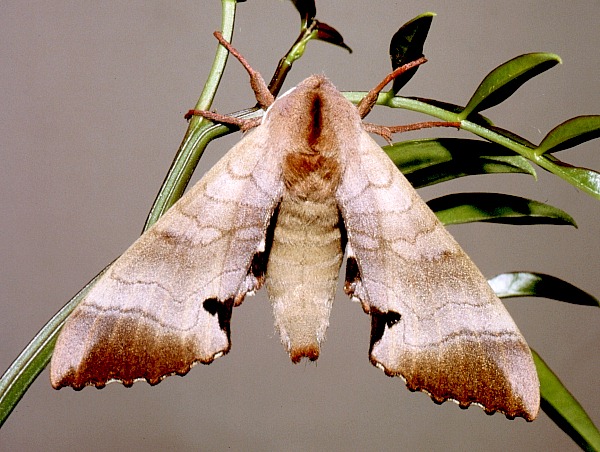
Marumba gaschkewitschii occurs in most habitats, including cities and orchards. Particularly common in montane forests rich in species of Prunus and Pyrus (Mell, 1935). Common in the hills to the west and north of Beijing in the Ziziphus/Vitex/Rhus vegetation zone.
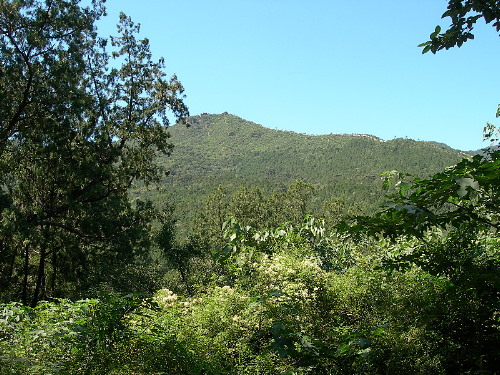
China: iv (Beijing); 24.iv-vi (Shandong). Mongolia: 21.iv (Övö-Hangaj Province); 3.v (Khovd Province); 9.vii (Vostochnyy Province). Russia: 20.vi (Buryatia).
Marumba gaschkewitschii s.l. has one to three generations a year. One is usual in Liaoning and Beijing, two in Ningxia, Hebei, Shandong, Jiangsu and Zhejiang; and three in Jiangxi (Chu et al., 1979). (Full-grown larvae were abundant around Beijing in late August 2003 (Pittaway, pers. obs. 2003).) Mell (1935) noted three to four generations (between 8.iii-5.x) in northern Guangdong and four to five generations (between 15.ii-2.xi) in southern Guangdong.
OVUM: Pale, translucent jade green at first, but developing a yellow sheen; oval (2.07 x 1.57mm), shiny and smooth.
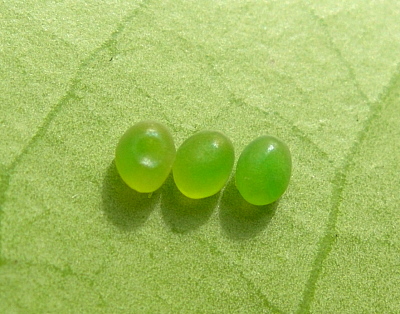
LARVA: Full-fed 75--83mm.
Generally feeds at between 0.5 and 1.5m off the ground on terminal branches of bushes rather than trees. Smaller plants set in amongst other shrubs are preferred. Larvae can be met with at very high densities, withn often four or five per branch.
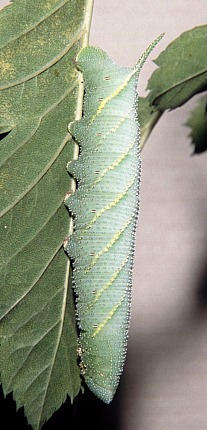
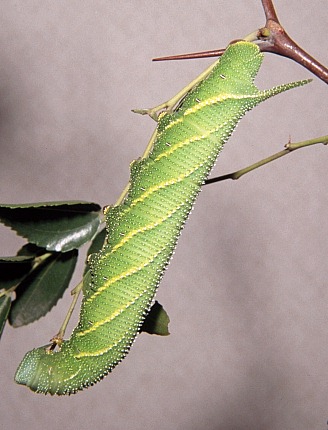
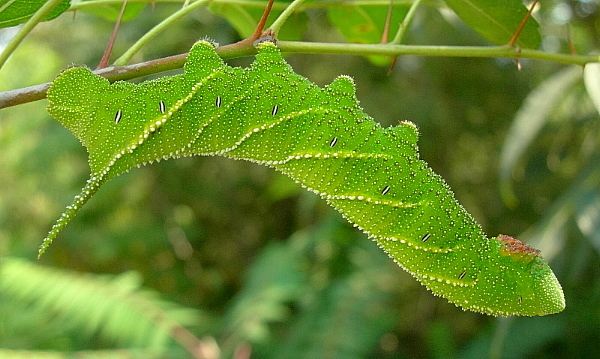
PUPA: 40--48mm. Reddish mahogany brown and glossy; tapering caudad from a blunt head and thorax. Head tuberculate, with two vertical, blunt, broad crests frontad. Proboscis not present, but replaced by a knob-like tubercle. Wings smooth, abdominal segments finely punctate. Spiracular ridges present on movable abdominal segments. Cremaster broadly conical, with a sharp point; tuberculate. Similar to that of Callambulyx tatarinovii, but head more rough and with two crest-like tubercles frontad, as found in most species of Marumba. Formed in an almost silk-free cell in the soil. The overwintering stage.
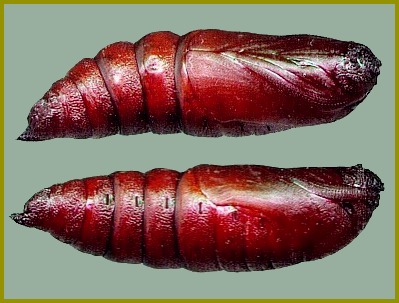
Larval hostplants. Recorded in China on Eriobotrya japonica and various species of Malus, Prunus and Pyrus (Mell, 1922b; Yang, 1978; Chu et al., 1979; Chu & Wang, 1980). It is a pest of Japanese apricot (Prunus mume) in Shaanxi (Pittaway & Kitching, 2000). The majority of hostplant records for Marumba gaschkewitschii are Rosaceae but there are two reliable records for Marumba 'gaschkewitschii' irata on Salix in Yunnan (Mell, 1922b). Yang (1978) and Chu & Wang (1980) also give Ziziphus mauritiana [Z. jujuba]. The first author was able to confirm this unusual hostplant by finding numerous full-grown larvae on Z. jujuba shrubs in the hills west of Beijing (Xiangshan) during late August (Pittaway, pers. obs. 2003). Larvae were also common on apricot (Prunus armeniaca) at Chengde farther north. However, records from Buxus microphylla and Euonymus alatus (Chang, 1989) are suspect, while those on Vitis vinifera (Chu et al., 1979; Chu & Wang, 1980) are probably erroneous. The source and veracity of the record on Weigela (Zhang, 1994) are unknown.
In captivity the larvae found on Ziziphus and Prunus armeniaca readily transferred to Crataegus (Pittaway, pers. obs. 2003).
Recorded in Primorskiy Krai, Russia, on Prunus, Pyrus and Crataegus (Derzhavets, 1984); also on Malus baccata (Izerskiy, 1999b).
Recorded in Korea on Kerria japonica, Prunus mume, Prunus persica, Prunus salicina, Prunus serrulata, Malus pumila and Pyrus pyrifolia var. culta (Park et al., 1999). However, records from Buxus microphylla var. koreana are suspect.
Unknown.
China: Lowlands of eastern China, from Beijing and Shandong (Weihai; Jinan; Yantai; Qingdao) south through Shanxi (Zhongtiao Shan) and Hubei (Mufu Shan) to the Yangtze river.
Mongolia: Khovd Province (Bulgan River, 10Km east of Jarantaj) (Grosser, 1982); Övö-Hangaj Province (20Km south of Khovd); Vostochnyy Province (Derzhavets, 1977); Bayanhongor Province (Bogd Sum, 33km SW of Bogd, Orog Nuur [lake]) (Knyazev, Makhov, Matov & Yakovlev; 2020); Bulgan Province (Khogno Khan Uul (Mts.), 22km W of Rasaant, 1270m); Selenge Province (Zuunburen Soum, Gangiin tokhoi; Shaamar).
Russia: Buryatia (Selenduma; 20Km S Ulan-Ude (Daba, iNaturalist 2014)); Transbaikalia (Daurskii Nature Reserve); Chita (Edinenie, Onon River).
The core distributions of the current four subspecies of Marumba gaschkewitschii are as follows:
There is a pair in the CMNH from Lanzhou in central Gansu and also a female in the NHMUK from the Chin Hills in Burma/Myanmar.
Three former subspecies, namely Marumba gaschkewitschii echephron (Boisduval, [1875]), Marumba gaschkewitschii harutai Eitschberger & Ihle, 2012, and Marumba gaschkewitschii irata Joicey & Kaye, 1917, are now treated as distinct species (Eitschberger, 2012).
(see above).
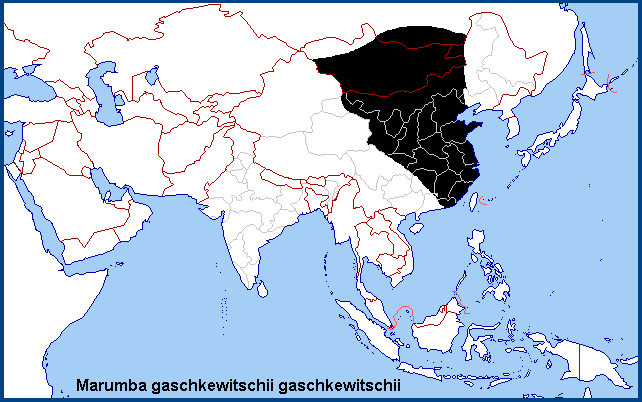
Holarctic; eastern Palaearctic region. Pleistocene refuge: Polycentric -- Manchurian, Japanese, Sinopacific, Sinotibetan and Yunnan refugia.
 Return to Sphingidae of the Eastern Palaearctic species list
Return to Sphingidae of the Eastern Palaearctic species list